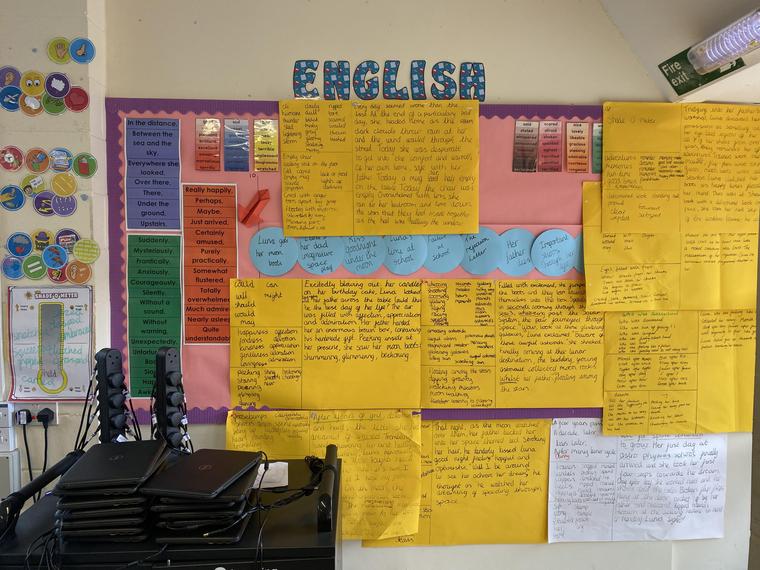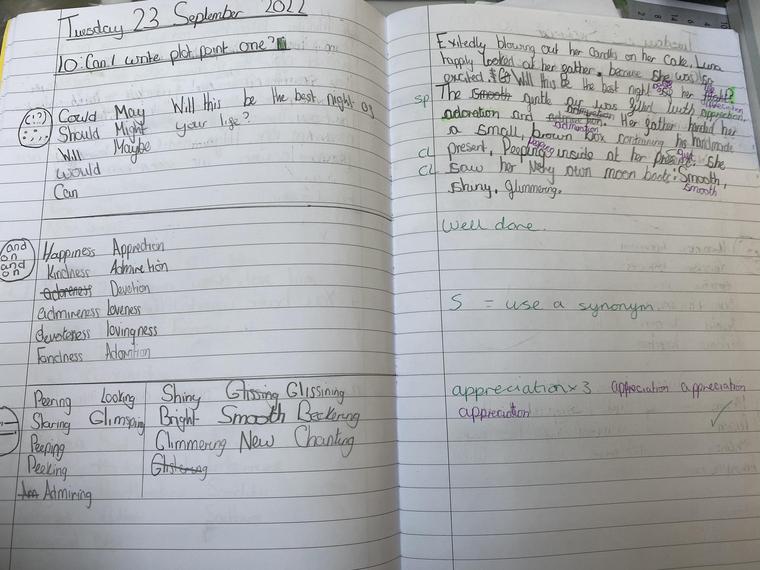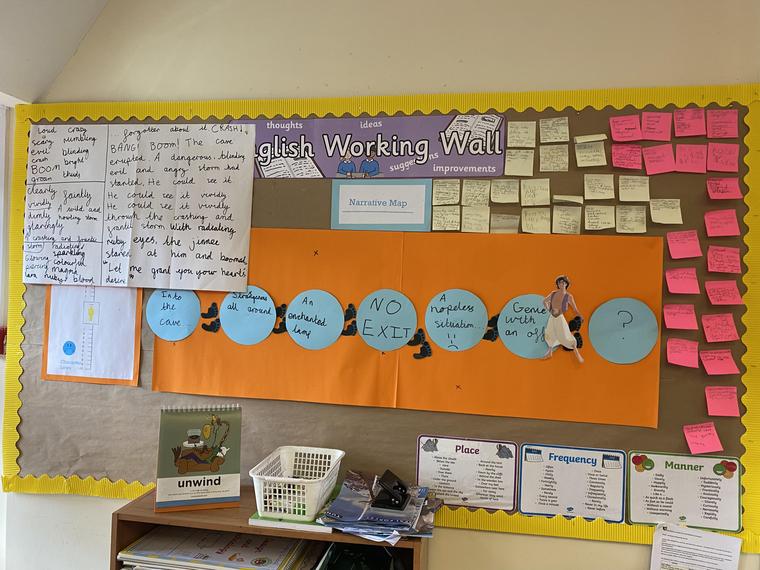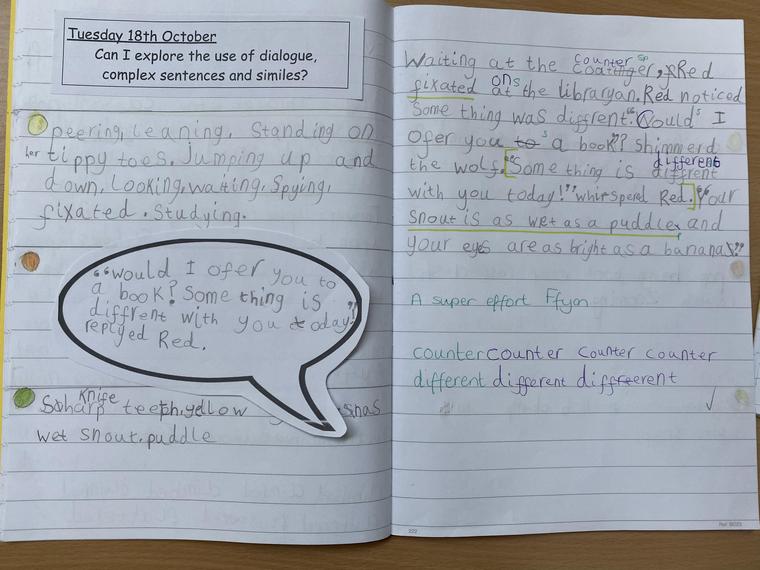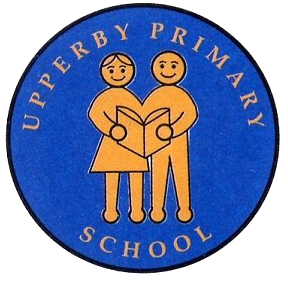English
Our Phonics Lead is Miss Wilson, our Reading Lead is Mrs Boothman and our Writing lead is Mrs Oliver.
Reading
Phonics
Supporting your child at home with phonics
The most important thing you can do with your child at home is read to them and with them each night.
Your child will bring home a reading book each week which matches their phonics level in school. Please read this book three times with them before returning to school to be changed. Children are also able to access the phonic book they have been reading in class through their Oxford Owl log in. This provides an extra reading book for you and helps the children become more confident with their reading in class.
If you would like to purchase a pack to support your child's reading at home please contact the office.
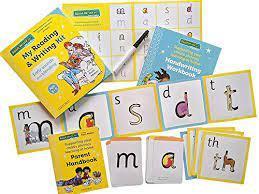
Read Write Inc.
We use Read Write Inc. Phonics which is a complete literacy programme for 3 to 6 year olds that are learning to read and write. The programme uses synthetic phonics to teach reading and it covers all of the National Curriculum requirements for literacy and language.
This approach:
- Gets children decoding and comprehending quickly. The special 'three reads' approach ensures that all children gain accuracy, fluency and a good understanding of the text.
- Ensures children read storybooks and non-fiction books matched to their growing phonic knowledge.
- Leaves no child behind. Initial and on-going assessment to track every child's progress.
- Prevents downtime. Direct teaching followed by partner practice means that every child participates in the whole lesson.
We begin using Read Write Inc. when our pupils are in nursery. The main focus in nursery class is language comprehension. It is vital to embed oral activities during the nursery years. To support our children in the Nursery we model speaking in whole sentences and do lots of talking throughout the day especially in play!
We model how to form sentences and get children to add their ideas and repeat these back! We use second tier vocabulary with children throughout the day to extend vocabulary for example we might say “Children, this morning Charlie looks sad. In fact, he does not just look sad, he looks upset and tearful”.
We have planned storybooks throughout the year that children grow to love, connecting them to the role play area and other areas of the Nursery environment, encouraging children to ‘jump in’, ‘join in’, use ‘phrases to keep forever’. We start with fairy tales and build up a wider bank of stories from here. These stories are in addition to the wealth of stories, nursery rhymes and songs that are part of the nursery day.
From early on the Nursery children are introduced to a carpet buddy and are encouraged to turn to their buddy to share ideas and answers. This leads into what will be expected of them later in reception when they begin more formal Read, Write, Inc sessions.
In reception, children start by learning the first 30 sounds in short, daily sessions. Pupils begin to read storybooks and non-fiction books that are closely matched to their developing phonic knowledge. The sessions are lively and interactive. They begin to write confidently and learn to spell using sounds that they know.
Their progress is assessed at the end of every half-term and they are grouped according to the level they are working at. This ensures that teaching is always focused precisely on what pupils need and the pace of learning is fast. If we are ever concerned about a child's progress in reading, we provide 1:1 intervention for 10/15 minutes a day to address this and accelerate their progress. These sessions are delivered by highly skilled support staff who have received specific Read Write Inc. 1:1 intervention training.
Most pupils complete the Read Write Inc. programme by the end of Year 1 and are ready to progress to the next stage of their learning. Read Write Inc Literacy and Language begins in year 2 and continues until Year 6 and is a complete literacy programme matched to the National Curriculum. The teaching of reading does not stop when children complete the Read Write Inc. Phonics programme. The skills of reading comprehension are a considerable focus of the Read Write Inc. Literacy and Language programme that children begin when they complete Read Write Inc. phonics.
This approach:
- Gives every child a deep understanding of what they read. Complete texts from leading authors are introduced using the special 'three reads' approach.
- Fully prepares every child for writing. The teacher models planning, drafting and revising texts. Children mirror this process.
- Teaches grammar in context. This enables children to apply grammar concepts to their own writing.
- Supports the grammar and punctuation aspects of the Key Stage 1 and 2 statutory assessments. It includes practice tests to build children's confidence.
- Creates articulate speakers. Children learn how to debate and present.
We have held various parent sessions during the autumn term, to demonstrate what Read Write Inc. is and also how you can support your child at home.
Reading Ambassadors
Our Year 6 reading ambassadors are proud to represent reading at Upperby. Over the course of the year they will be busy doing lots of jobs including making sure our library stays nice and neat and reading with some of our younger students. They are very excited to get started!
Writing
Writing Process
Message Centre
Bringing Joy, Purpose and Magic to Early Writing
At our school, we believe that all children should experience joy, purpose and magic when they begin to write. That’s why we use The Message Centre—a creative and inspiring approach to writing and mark making that transforms how children see themselves as writers.
Rather than seeing writing as a task, children experience it as messaging—a meaningful, playful and real way to communicate. This small shift makes a huge difference. When messaging becomes part of the classroom, the phrase ‘reluctant writer’ disappears. Children want to message—they love its simplicity, warmth, and sense of purpose.
What is The Message Centre?
The Message Centre is a playful reimagining of writing. Children write real messages to real people—adults, friends, characters, or even themselves. These messages are shared, discovered, hidden and celebrated, turning writing into something magical and irresistible.
Children learn that their marks matter, that their writing has meaning, and that writing is for them.
Why We Use It
The Message Centre is much more than a writing resource. It supports development in key areas:
-
Writing and Mark Making
Encourages purposeful early writing in a natural, joyful way. -
Reading
Children love to discover messages left for them—boosting motivation to read. -
Mathematics
Messages can include numbers, patterns, puzzles and shapes, adding playful maths to everyday learning. -
Language and Communication
Messaging helps children express themselves, share ideas and develop rich language skills. -
Engagement and Confidence
Children are drawn in by the magic of messages. They feel seen, heard and excited to take part.
The Impact We See
-
Children develop confidence and joy as writers
-
Writing becomes a meaningful part of continuous provision
-
Families begin to see writing as something that can ‘go home’
-
A strong reading and writing culture develops across the classroom
-
Especially impactful for boys and those less confident in mark making
.
Drawing Club
Why We Use Drawing Club in Reception
Bringing Stories to Life Through Language, Imagination and Joy
At our school, we believe in nurturing a deep love of stories, creativity and language from the very start of a child’s learning journey. That’s why we use Drawing Club with our children.
Drawing Club is a unique and magical approach to early literacy that combines picture books, traditional tales and animations with drawing, storytelling and rich vocabulary. It invites children into a world full of imagination—where anything can happen—and often does!
What is Drawing Club?
Drawing Club is a highly engaging, story-based approach designed for young children. Each session begins with Time Together as a whole class, where we enjoy a story and introduce new vocabulary. Children are then given the opportunity to respond through drawing, discussion, and imaginative play.
It’s an approach that encourages children to:
-
Think creatively
-
Use language in meaningful ways
-
Develop fine motor skills
-
Feel confident to express their ideas
-
Most importantly, have fun with learning!
Why We Use It in Reception
Drawing Club supports many key areas of early development:
-
Language and Vocabulary Development
Children are introduced to rich, exciting vocabulary in context. They learn to use new words in their own storytelling and play, giving them a head start in communication and understanding. -
Love of Stories and Books
By using high-quality picture books and animations, Drawing Club helps to build a strong connection between reading and enjoyment. Children begin to see stories as exciting, magical and worth returning to again and again. -
Imagination and Creativity
Drawing Club gives children the freedom to explore ideas, create new characters, and invent their own endings. It celebrates the unique imagination of every child. -
Fine Motor Skills and Mark Making
Through drawing and early writing, children develop the physical skills they need for handwriting—while engaging in purposeful, meaningful activities. -
Confidence and Joy
Drawing Club helps even the most hesitant child feel successful. Every idea is valued, and every child has a voice in the world of story.
A Flexible, Child-Centred Approach
There is no fixed scheme or script. Drawing Club is led by the teacher but shaped by the children. This means we can adapt sessions to suit the needs, interests and abilities of our class, creating a rich, responsive learning environment.
It allows us, as educators, to bring ourselves and our love of stories into our teaching—helping children to see storytelling as a joyful, shared experience.
The Impact We See
Since introducing Drawing Club, we’ve seen:
-
Increased engagement in mark making and early writing
-
Improved use of vocabulary across the curriculum
-
Greater confidence in speaking and sharing ideas
-
A stronger sense of community and collaboration in class
-
A joyful, playful approach to literacy that children love
Curious Quests
An immersive adventure into storytelling, imagination and joyful learning
At our school, we believe in giving children a childhood filled with wonder, creativity and the freedom to imagine. That’s why, in Year 1, we build on the success of Drawing Club by introducing children to The Curious Quests—a magical extension of our story-rich, play-based approach to learning.
The Curious Quests is not a scheme or a set of worksheets. It’s an open-ended, immersive experience that combines story, poetry, adventure, and make-believe—all with the goal of keeping children deeply engaged in their learning and excited to express themselves through language, writing, and play.
What is The Curious Quests?
The Curious Quests is a bridge from Reception into Year 1. It gives children the space to explore ideas, solve problems, invent characters, and live out stories—through drawing, writing, role play, construction, junk modelling, outdoor learning, and more.
Each Quest includes:
-
Short carpet sessions to spark ideas and introduce vocabulary
-
Group work that supports collaboration and communication
-
Exploration through open-ended, continuous provision
-
Opportunities to apply phonics, SPaG, and storytelling skills
It’s a carefully planned yet flexible learning landscape—where writing is purposeful, meaningful, and full of joy.
Why We Use It
The Curious Quests supports children’s development in many powerful ways:
-
Keeps the magic of story and language alive
Building on Drawing Club, Quests show children that writing and storytelling are for them. -
Fosters independence and confidence
Children are encouraged to take the lead in their learning—making choices, solving problems, and following their curiosity. -
Supports high-quality writing
Instead of teaching rigid text types, we focus on helping children write with purpose, imagination, and heart—aligned with the National Curriculum expectations for Year 1. -
Develops key skills through play
Whether it’s mark making, sentence writing, or vocabulary building, children learn through doing—within rich, purposeful environments. -
Promotes joy, curiosity and engagement
The Curious Quests helps ensure that the excitement of learning doesn’t stop after Reception.
Is The Curious Quests Right for Your Child?
If you want your child to:
-
Love stories and language
-
See writing as a joyful and creative experience
-
Build confidence, curiosity and independence
-
Continue learning through imaginative play
-
Be part of a learning environment that celebrates who they are...
The Write Stuff
A clear, practical approach to writing success
At our school, we believe that all pupils deserve to feel confident, supported, and successful in their writing. That’s why we use The Write Stuff by Jane Considine—a structured, step-by-step approach that helps every child become a skilled and purposeful writer.
What is The Write Stuff?
The Write Stuff combines teacher modelling, rich vocabulary, and structured thinking to give children the tools they need to write with fluency, precision and creativity.
At its core, this approach helps pupils to:
-
Develop sentence confidence – Writing is broken down into manageable, achievable chunks.
-
Expand vocabulary and ideas – Children are taught how to make their writing engaging and imaginative.
-
Organise their thinking – Lessons help pupils create clear, cohesive, and well-structured pieces of writing.
Whether your child is just starting out or already a keen writer, The Write Stuff provides a supportive framework to help them move forward with clarity and purpose.
Why We Use It
-
Clarity and Structure
Children benefit from a consistent approach that shows them how to write, not just what to write. -
Focus on Quality
High-quality modelling, examples, and discussion ensure pupils see what good writing looks like—and how to get there. -
Builds Confidence Step by Step
Writing is introduced in small, manageable parts, helping children feel proud of their progress at every stage. -
A Shared Language for Writing
Pupils and teachers use a common framework and vocabulary to talk about writing, making feedback and reflection more meaningful.
Supporting Teachers and Pupils
The Write Stuff also transforms how writing is taught. It helps teachers:
-
Deliver focused, well-structured lessons
-
Adapt lessons to suit all learners and year groups
-
Track progress clearly and consistently
-
Encourage creativity within a secure structure
The Impact We See
Since implementing The Write Stuff, we’ve seen:
-
Greater engagement in writing across all year groups
-
Stronger sentence construction and vocabulary use
-
Improved confidence and independence in writing
-
A clear progression of skills throughout the school
By using The Write Stuff, we ensure that writing at our school is not only purposeful and high-quality—but also enjoyable, empowering, and accessible to all.
Our writing process on our working walls
